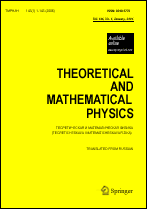|
This article is cited in 2 scientific papers (total in 2 papers)
Multisoliton solutions of the two-component Camassa–Holm equation and its reductions
Gaihua Wang
School of Mathematics and Physics, Nanjing Institute of Technology, Nanjing, China
Abstract:
The Bäcklund transformation for an integrable two-component Camassa–Holm ($2$CH) equation is presented and studied. It involves both dependent and independent variables. A nonlinear superposition formula is given for constructing multisoliton, multiloop, and multikink solutions of the $2$CH equation. We also present solutions of the Camassa–Holm equation, the two-component Hunter–Saxton ($2$HS) equation, and the Hunter–Saxton equation, which all arise from solutions of the $2$CH equation. By appropriate limit procedures, a solution of the $2$HS equation is successfully obtained from that of the $2$CH equation, which is worked out with the method of Bäcklund transformations. By analyzing the solution, we obtain the soliton and loop solutions for $2$HS equation.
Keywords:
two-component Camassa–Holm equation, two-component Hunter–Saxton equation, Bäcklund transformation, soliton, reduction.
Received: 12.09.2022
Revised: 21.10.2022
Citation:
Gaihua Wang, “Multisoliton solutions of the two-component Camassa–Holm equation and its reductions”, TMF, 214:3 (2023), 359–386; Theoret. and Math. Phys., 214:3 (2023), 308–333
Linking options:
https://www.mathnet.ru/eng/tmf10366https://doi.org/10.4213/tmf10366 https://www.mathnet.ru/eng/tmf/v214/i3/p359
|


| Statistics & downloads: |
| Abstract page: | 188 | | Full-text PDF : | 54 | | Russian version HTML: | 112 | | References: | 43 | | First page: | 1 |
|




 Contact us:
Contact us: Terms of Use
Terms of Use
 Registration to the website
Registration to the website Logotypes
Logotypes









 Citation in format
Citation in format 
